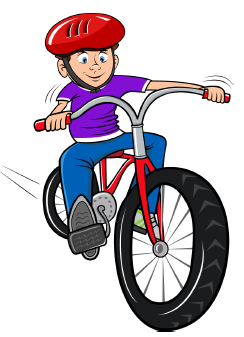This problem solving activity has a measurement focus.
It’s 7km from Tim’s house to where his Grandma lives.
It’s uphill on the way there so he can only cycle at 14kph but he can do 21kph on the way back.
Tim leaves his house at 6pm.
How long can he stop at his Grandma’s house if he wants to be back home for his favourite TV programme at 7pm?
- Calculate accurately using units of time and speed.
- Explain their methods and reasoning using correct mathematical terms.
- Devise and use problem solving strategies to explore situations mathematically (guess and check, draw a diagram).
Speed is a rate at which something or someone moves. It is a relationship between distance and time. In this problem students need to calculate an unknown quantity of time, distance, or speed from the other two given measures. To work successfully with the given information, they need to know standard units of measure of time (including the number of minutes in an hour) and distance, and need to have a basic understanding of speed as a distance/time rate expressed in kilometres per hour.
The Problem
It’s 7km from Tim’s house to where his Grandma lives. It’s uphill on the way there so he can only cycle at 14kph but he can do 21kph on the way back.
Tim leaves his house at 6pm. How long can he stop at his Grandma’s house if he wants to be back home for his favourite TV programme at 7pm?
Teaching Sequence
- Discuss reasonable cycling speeds as an introduction to this problem. Ask the students to justify their estimates with reference to their general knowledge (e.g. followed a cyclist in the car, know the speeds of professional cyclists).
- Pose the problem.
- Brainstorm for strategies that will help solve the problem (eg. drawing a picture of the trip.)
- As the students work on the problem with a partner ask questions that focus their thinking on the use of units of time and speed?
What does 14 kmph mean?
How far would Tim travel in 2 hours?
How far would Tim travel in 30 minutes? How did you know that? - Share solutions.
Extension
At what time should Tim leave home if he wants to spend 45 minutes at his grandma's?
Solution
The trip to grandma’s takes 30 minutes. (If he were travelling at 7kph he would take an hour. Travelling at twice that speed halves the time.) This means that the home trip takes a third of an hour or 20 minutes. Tim’s total travelling time is therefore 50 minutes. If he spends 10 minutes with grandma he can still get home to watch his favourite programme.
Solution to the Extension
Tim will still need to spend 50 minutes travelling. However his total time away here will be 50 + 45 = 95 minutes. 95 minutes before 7 pm is 5:25 pm. Another way to look at this is that this time, he spends 35 minutes more with his grandma. So he has to leave home 35 minutes earlier than 6 pm. He then has to leave at 5:25 pm.
